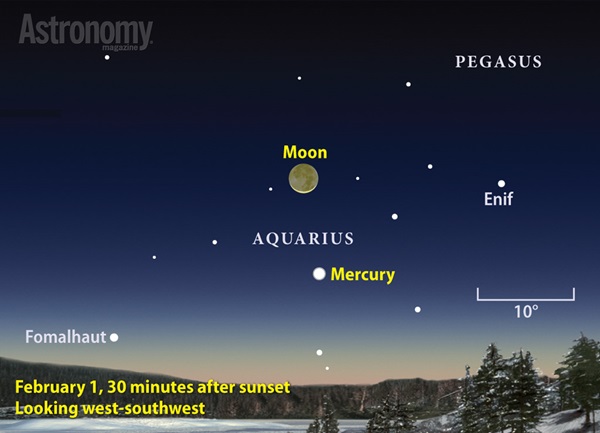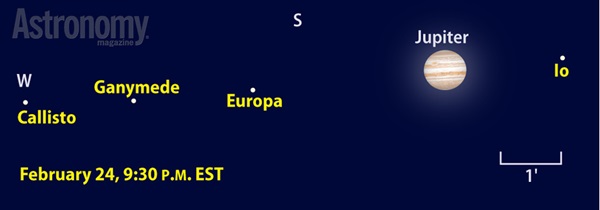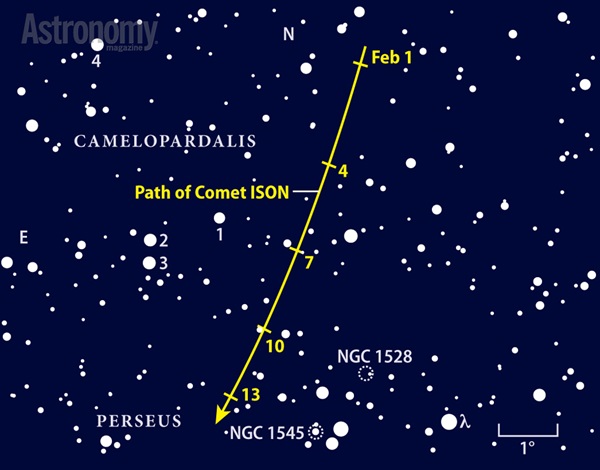
Key Takeaways:

The Moon points the way to Mercury in early February, when the innermost planet appears near its maximum altitude after sunset.
Astronomy: Roen Kelly
Planets adorn the night sky from dusk to dawn in February. Just one month removed from its peak visibility, Jupiter provides a smorgasbord of details from sunset until the wee hours. Mercury continues to shine brightly in the evening sky in early February, but it soon passes between the Sun and Earth and re-emerges before dawn at month’s end. The morning sky also offers superb views of Mars and Saturn as they approach their springtime peaks. But the focus of naked-eye observers during the predawn hours has to be Venus, which shines at its brightest this month.
As February opens, innermost Mercury is in the midst of its best evening apparition for northern observers during 2014. (It peaked at greatest elongation January 31.) On the 1st, the planet lies 11° high in the west-southwest 30 minutes after sunset. Coincidentally, Mercury appears the same distance below a slender crescent Moon. Grab your binoculars and scan halfway between the Moon and the horizon. You shouldn’t have any trouble spying the planet, which shines brightly at magnitude –0.6.
Mercury fades quickly during the next week, dimming by 0.2 magnitude with each passing day. It dips to 1st magnitude by February 7 and becomes difficult to spot in the twilight. Just a week later, on February 15, it passes between the Sun and Earth and slips into the morning sky, where we will visit later.
Uranus provides more of a challenge to binocular observers. In mid-February, the magnitude 5.9 planet stands about 20° above the western horizon as twilight fades to darkness. Look for it in southern Pisces some 5° southwest of 4th-magnitude Delta (δ) Piscium. On February 3, the planet lies 3° south of the crescent Moon.
Don’t confuse Uranus with a similarly bright star just 0.5° to its east. You can tell the two apart through a telescope, which reveals the planet’s 3.4″-diameter disk and blue-green color. Uranus lies within 0.25° of this same star from February 11 to 18, and their relative motion from night to night should be easy to spot.After the challenge of spotting Uranus, Jupiter will seem like a breeze. The planet gleams at magnitude –2.5 and stands some two-thirds of the way to the zenith in the eastern sky as darkness falls. Jupiter reached opposition and peak visibility in early January and shows little decline this month. The giant world’s disk shrinks only slightly, from 46″ to 42″ across, which is still plenty big enough to show fine details through telescopes of any aperture. Look for two dark equatorial belts sandwiched around a brighter equatorial zone on any clear night. When Earth’s turbulent atmosphere settles down and the jovian disk appears exceptionally crisp, look for a whole series of alternating belts and zones.

Mars and Saturn climb higher in the sky after midnight as they both prepare to reach their peak this spring.
Astronomy: Roen Kelly
Jupiter lies in the central part of Gemini the Twins. This region passes nearly overhead for Northern Hemisphere observers in mid-evening and doesn’t set until after 4 a.m. local time. The planet moves westward against the starry background during February, ending the month some 2° south of 3rd-magnitude Epsilon (ε) Geminorum.
The world’s four bright moons offer endless entertainment. Once in a while, the satellites line up in order of their distance from the planet. The evening of February 24 provides perhaps the month’s best opportunity to see such an alignment. Io then lies east of and closest to the planet with Europa, Ganymede, and Callisto lined up in order west of Jupiter.
As each moon orbits the giant planet this month, it experiences a similar sequence of events. First, the satellite crosses in front of, or transits, Jupiter. Soon thereafter, the moon’s shadow transits the jovian cloud tops. (The time delay depends on the moon’s distance from Jupiter and the Sun-Jupiter-Earth viewing angle.) Half an orbit later, the moon disappears behind Jupiter’s western limb. The sequence ends when the moon leaves Jupiter’s shadow at some distance off the planet’s eastern limb. As the eclipse ends, the moon brightens slowly as sunlight gradually returns to its surface.
February features plenty of interesting satellite events. At 11:36 p.m. EST February 3, Io begins to transit Jupiter’s disk. The moon’s shadow starts its own journey across the planet’s face at 12:19 a.m. The transit ends at 1:52 a.m., and the shadow lifts back into space 42 minutes later.
By the next evening, speedy Io has progressed halfway along its orbit. The moon moves behind Jupiter starting at 8:56 p.m. EST. Exactly three hours later, Io returns to view as it exits Jupiter’s shadow 13″ from Jupiter’s eastern limb. It takes this satellite three minutes to fully brighten.Jupiter’s outermost major moon, Callisto, transits Jupiter on February 5 starting at 9:10 p.m. EST. Because Callisto travels a wider orbit than Io, it moves more slowly and takes longer to cross Jupiter’s disk. The transit doesn’t wrap up until 12:34 a.m. It’s worth staying up even later to see Europa transit Jupiter. This event begins at 3:53 a.m. EST; 12 minutes later, a large shadow appears on the jovian cloud tops. Don’t be fooled — this is Callisto’s shadow, not Europa’s. The outer moon’s shadow trails its own disk by seven hours.

The apparent distances from Jupiter of the four Galilean moons often don’t match their orbital hierarchy, but they do February 24.
Astronomy: Roen Kelly
You’ll have to wait until late evening to view another planet. Mars rises shortly after 11 p.m. local time in early February and some 90 minutes earlier by month’s end. On the 1st, the Red Planet stands 5° north-northeast of blue-white Spica, Virgo the Maiden’s brightest star. At magnitude 0.2, Mars appears twice as bright as 1st-magnitude Spica. The planet’s slow easterly motion carries it to a point some 6° northeast of Spica by February 28. Mars then shines at magnitude –0.4 and bests Spica by a factor of 3.6.
The planet’s rapid brightening signals that it will soon be making a close approach to Earth. In early April, Mars will appear brighter than at any time since 2007 as it reaches opposition and peak visibility. The planet’s apparent diameter also grows larger as opposition looms. When viewed through a telescope in early February, it spans 8.9″; the disk swells by 30 percent (to 11.5″) by month’s close. Eight-inch and larger scopes should provide nice views of martian surface features.
Plan to view Mars in the early morning when it climbs nearly halfway to the zenith in the southern sky. Peak elevation comes around 5 a.m. local time in early February and shortly after 3 a.m. late in the month. If you observe the planet at the same time each night, features slowly change position because Mars takes 24 hours and 37 minutes to complete a rotation.
The giant volcano Olympus Mons lies near the martian disk’s center during February’s first few mornings. During February’s final week, the conspicuous dark feature Syrtis Major dominates the planet’s central region. Also look for Mars’ white north polar cap. Although the cap is now waning — summer begins in the northern hemisphere February 14 — it should stand out because the planet’s north pole tips in our direction.
Saturn pokes above the horizon roughly two hours after Mars. The ringed planet lies against the backdrop of Libra the Balance. It shines at magnitude 0.5, two full magnitudes brighter than any of Libra’s stars. Saturn’s southerly position this year means that it won’t climb high for observers at mid-northern latitudes. For the best views in February, wait until an hour or so before dawn. Even a small telescope reveals the planet’s 17″-diameter disk encircled by a ring system that spans 39″ and tilts 23° to our line of sight.For amateur astronomers, Saturn offers more moons to view than Jupiter does. None rises to the brightness of Jupiter’s four largest, however. Only 8th-magnitude Titan shows up through the smallest scopes. Simply look for the brightest point of light near the planet. You’ll find Titan south of Saturn on February 2/3 and 18/19 and north of the planet February 11 and 27.

The brightest planet peaks at magnitude –4.9 in mid-February, when observers under dark skies might see it cast a shadow.
Astronomy: Roen Kelly
Saturn’s outermost major moon, two-faced Iapetus, varies in brightness by a factor of five as it orbits the planet. The best time to look for it this month comes February 16 when it passes 2.2′ due north of the ringed world. It then glows at 11th magnitude and should show up easily through a 6-inch scope.
Three other moons appear through 4-inch instruments. Tethys, Dione, and Rhea glow at 10th magnitude and all orbit inside Titan. It is worth the effort to view the trio when they lie near one another before dawn February 11 and 21. On the 11th, the three form a 44″-long line west of Saturn; on the 21st, they make an even tighter triangle east of the planet.
By the time twilight begins, Venus dominates the sky. The brilliant world rises some two hours before the Sun in early February, when it shines at magnitude –4.8. The morning “star” grows even more prominent as the month progresses and it climbs higher before dawn. Venus reaches greatest brilliancy (magnitude –4.9) February 15 before fading back to magnitude –4.8 by month’s end, when it comes up 2 1/2 hours before our star.
The view of Venus through a telescope changes dramatically during February. On the 1st, Earth’s neighbor spans 51″ and shows a thin crescent just 13 percent lit. By the 28th, Venus’ apparent diameter has shrunk to 33″, but the Sun then illuminates 36 percent of the disk.
You’ll find a crescent Moon nearby February 25 and 26 (with a phase of 20 percent and 11 percent, respectively).Mercury also appears in the morning sky late in the month, but it presents more of a challenge than it did on early February evenings. On the 27th, the innermost planet shines at 1st magnitude some 9° to the lower left of the waning crescent Moon. Binoculars offer you the best chance to spy the elusive planet.

A favorable libration brings Mare Smythii and Mare Marginis into view in early February.
NASA/Clementine/Arizona State University; Inset: NASA/GSFC/ASU
SEARCHING BEYOND THE NORMAL LUNAR LIMB
The first few evenings of February offer great views of rugged craters along the waxing crescent Moon’s terminator, the line that divides sunlight from darkness on the lunar surface. But after enjoying the sights for a few minutes, you might start to wonder if something is different about the scene. Then it dawns on you — there’s a lot more terrain than usual between Mare Crisium and the limb.
Mare Marginis and Mare Smythii appear as huge dark splotches instead of thin channels. Early February offers the best perspective (or libration) we can get on the Moon’s eastern zone. Our satellite’s rotation and revolution combine to let us see a bit beyond what our normal face-on view provides.
These two large dark zones are ponds of lava that welled up from below and froze billions of years ago. The northern one is Mare Marginis (the Border Sea), and the southern one is Mare Smythii, whose name honors British amateur astronomer Admiral Smyth. The white wall on the limb beyond Smythii consists of a series of crater rims, the largest belonging to Hirayama, Purkyne, and Babcock.
In between the two maria is Neper, a prominent crater with a lava-filled basin and central mountain. On Marginis’ northern flank, the rugged walls of Goddard ring a flat lava lake that flooded the impact site higher than the crater’s central peak. For a few evenings, the lumpy rim of Al-Biruni pokes above the limb just beyond Goddard.Each night after First Quarter phase February 6, the Moon’s orbit and spin combine to give the impression that the eastern part of Luna is rolling away from us. Watch for Goddard’s rim and Neper’s peak to stick up above the limb when they are in profile. By Full Moon on February 14, all the features past Crisium have spun beyond the limb. This sequence of views brought by a favorable libration repeats the next couple of months, but less prominently than in February.

Most meteor observers watch the annual showers, but dark skies can bring exceptional views of random flaring dust particles.
Tony Rowell
YOU DON’T NEED A SHOWER TO GET WET
February is typically a quiet month for meteor observers. No major showers occur, and the only minor one (the Alpha Centaurids) lies deep in the southern sky. But the occasional sporadic meteor can appear at any time. Experienced observers can expect to see half a dozen sporadics per hour from a dark-sky site.As with all meteor viewing, the highest rates occur in the early morning hours. Before dawn, an observer lies on the part of Earth that faces in the direction of our planet’s orbital motion. And in the same way a car driving through a snowstorm picks up more snowflakes on its front windshield, Earth sweeps up more meteors
on its leading edge.
| WHEN TO VIEW THE PLANETS | ||
| Evening Sky | Midnight | Morning Sky |
| Mercury (west) | Mars (southeast) | Mercury (southeast) |
| Jupiter (east) | Jupiter (west) | Venus (southeast) |
| Uranus (west) | Mars (southwest) | |
| Neptune (west) | Saturn (south) | |

The bright comet of November and December dims considerably as it moves from Camelopardalis into Perseus in early February.
Astronomy: Roen Kelly
ISON STARTS ITS TREK BACK TO THE OORT CLOUD
As Comet ISON (C/2012 S1) begins a long goodbye as it departs from the inner solar system in February, it should remain a telescopic treat in the rich star fields of the Perseus Milky Way. After the waxing Moon sets during the first 10 days of February, a 4-inch telescope under a dark sky should pull in the diffuse comet. From the suburbs, however, the comet may remain a disappointing smudge even through an 8-inch instrument. In the second half of February, the Moon-free observing window moves to the evening sky as the celestial visitor fades.
ISON should be fairly easy to track down. It lies roughly midway between brilliant Capella (Alpha [α] Aurigae) and bright Mirfak (Alpha Persei), drifting near a crumpled box of stars that represents the curled hand of Perseus the Hero. Take a few minutes to enjoy the open star clusters NGC 1545 and NGC 1528. The former is smaller and looks like a dancing stick man, while the latter is a beautiful large group visible through finder scopes and binoculars.
At low power, you might notice that ISON doesn’t appear like a typical round cotton ball. Bump up the power to 100x or more and take a closer look. Picture a slice of thin-crust pizza oriented almost edge-on with the point close to your nose. The comet’s coma (the point) should glow brightest with well-defined wings on each side. The fan-shaped dust tail (the pizza “toppings”) spans a broad angle but peters out quickly to the north because of our shallow observing angle.Next month, we will leave ISON behind and pick up a fresh comet: PANSTARRS (C/2012 K1). This dirty snowball promises to be a nice target from now until autumn. Meanwhile, we’ll leave ISON’s retreat to imagers and observers with large scopes.

Although Herculina wasn’t among the first 500 asteroids discovered, it’s bright enough this month to spy through a small scope.
Astronomy: Roen Kelly
HERCULINA ON DISPLAY IN TAURUS THE BULL
February provides a golden opportunity for observers to spot a high-numbered asteroid. On the 5th, point your telescope at 3rd-magnitude Zeta (ζ) Tauri, the southern horn of Taurus the Bull. The closest point of light in your eyepiece will be asteroid 532 Herculina. This main-belt asteroid remains a short hop away on other early February nights. While you’re in the area, stop by the Crab Nebula (M1). A 4-inch instrument will reveal this supernova remnant’s diffuse form.
German astronomer Max Wolf discovered Herculina on April 20, 1904, by noticing its displacement on images taken a few nights apart. You can use a similar technique to identify the space rock by making a quick sketch of the field and returning a night or two later to see which dot changed place.Herculina reaches 10th magnitude only when its orbit carries it close to Earth. It happens this year and next, but after that not until 2019. Herculina spans nearly 130 miles, which places it around 20th in size among all asteroids. It doesn’t reflect as much light as typical asteroids, however, which is why astronomers discovered many smaller ones before Herculina.
Martin Ratcliffe provides planetarium development for Sky-Skan, Inc. from his home in Wichita, Kansas. Meteorologist Alister Ling works for Environment Canada in Edmonton, Alberta.









